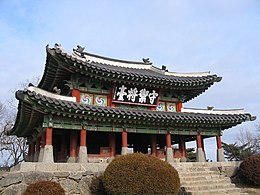
Back نامهانسانسونغ Arabic نامهانسانسونج ARZ Namhansanseong Catalan Namhansanseong Czech Festung Namhansanseong German Namhansanseong Spanish نام هان سن سونگ Persian Namhansanseong Finnish Namhansanseong French מבצר נמהאנסאנסאונג HE
You can help expand this article with text translated from the corresponding article in Korean. Click [show] for important translation instructions.
|
| UNESCO World Heritage Site | |
|---|---|
 Sueojangdae (command post; 2002) | |
| Location | Gwangju, Gyeonggi Province, South Korea |
| Reference | 1439 |
| Inscription | 2014 (38th Session) |
| Area | 409.06 ha (1.5794 sq mi) |
| Buffer zone | 853.71 ha (3.2962 sq mi) |
| Coordinates | 37°28′44″N 127°10′52″E / 37.47889°N 127.18111°E |
 | |
| Korean name | |
| Hangul | |
| Hanja | |
| Revised Romanization | Namhansanseong |
| McCune–Reischauer | Namhansansŏng |
Namhansanseong (Korean: 남한산성) is a historic mountain fortress city in Gwangju, Gyeonggi Province, South Korea. A UNESCO World Heritage Site, the fortress lies atop the mountain Namhansan and stretches 12 km in length. It served as an emergency capital city during the 1392–1910 Joseon period. The design is based on fortress architecture of East Asia, embodying aspects of four historical cultural styles: the Joseon of Korea, the Azuchi-Momoyama Period of Japan, and Ming and Qing China.[1][2]
It was extensively developed during the 16th to 18th centuries, a period of continuous warfare. The technical development of weaponry and armaments during this period, which saw the use of gunpowder imported from Europe, also greatly influenced the architecture and layout of the fortress. Namhansanseong portrays how the various theories of defense mechanisms in Korea were put to form by combining the everyday living environment with defense objectives. The fortress indicates how Buddhism played an influential role in protecting the state, and it became a symbol of sovereignty in Korea.[1][2]
It can be accessed from Seoul through Namhansanseong station of Seoul Subway Line 8.
- ^ a b "UNESCO NEWS, Namhansanseong". Retrieved 8 May 2015.
- ^ a b "Namhansanseong". UNESCO World Heritage Convention. Retrieved June 12, 2024.
© MMXXIII Rich X Search. We shall prevail. All rights reserved. Rich X Search